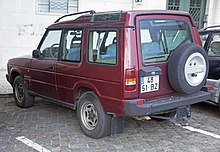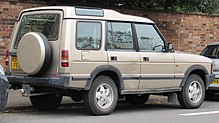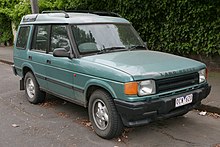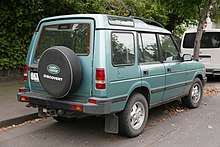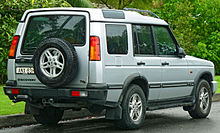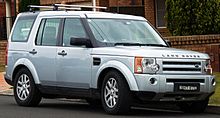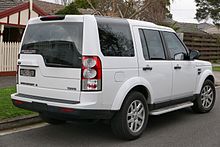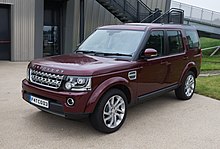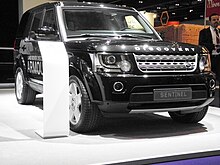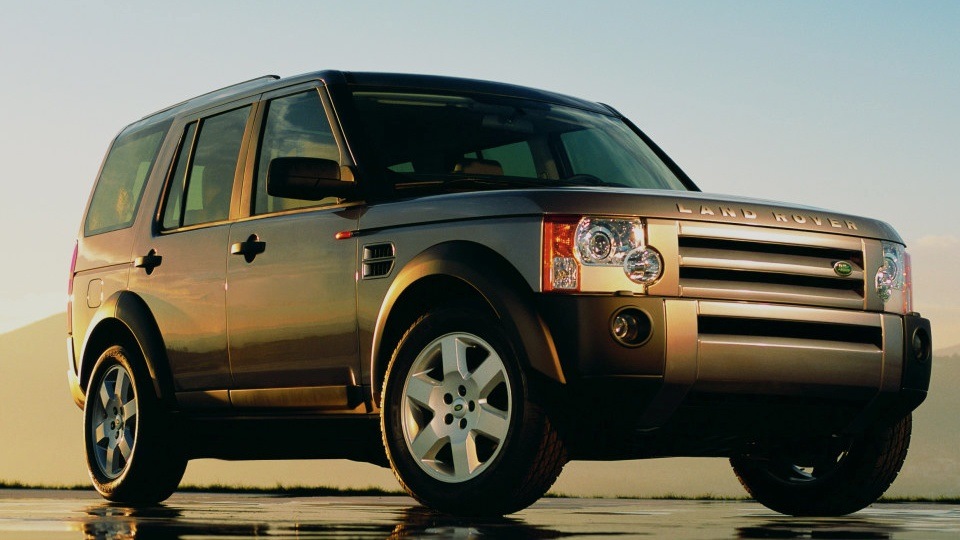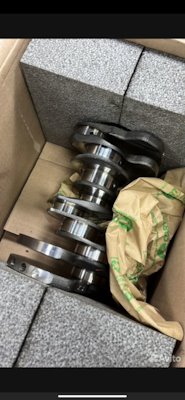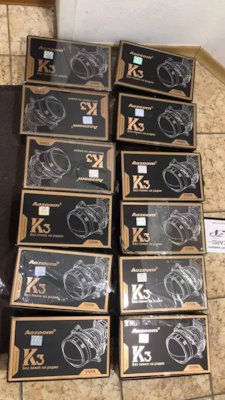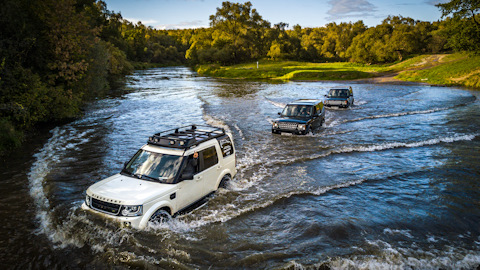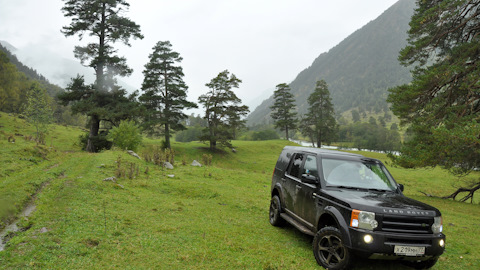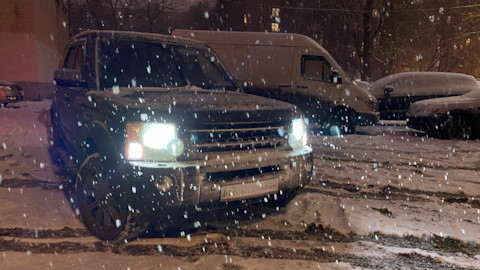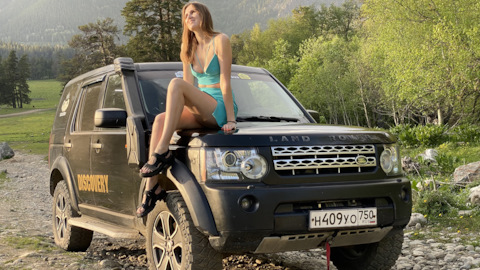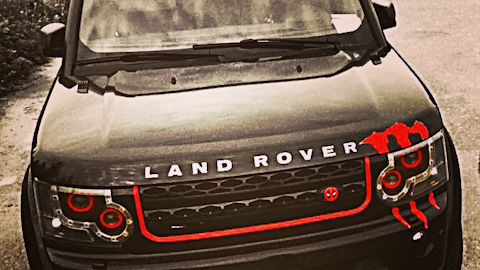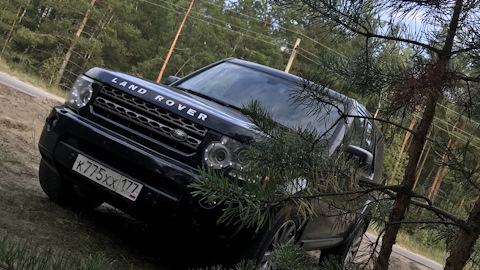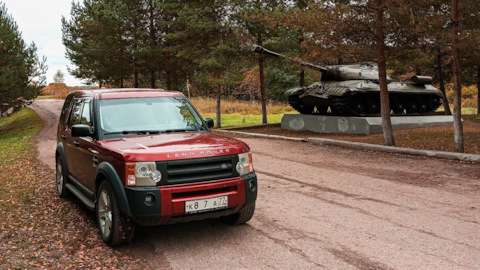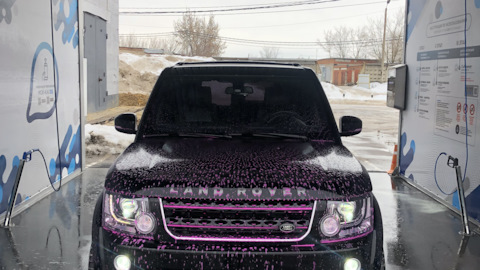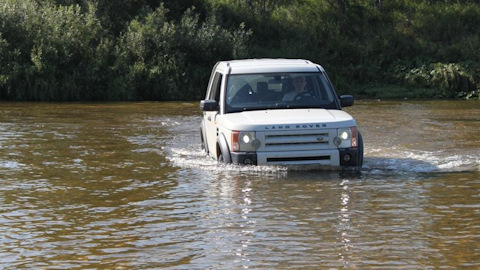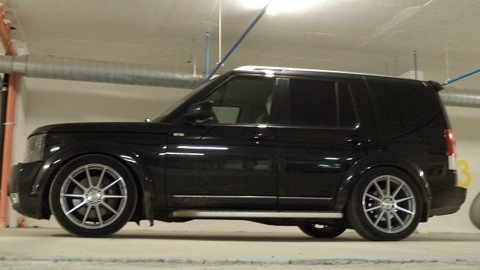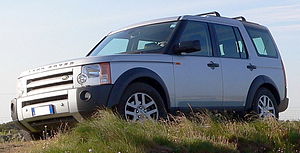История модели
Ленд Ровер Дискавери 3 дебютировал в 2004 году. Хотя стилистически внедорожник и напоминает предшественника, но отличия видны невооруженным взглядом. Такие элементы, как ассиметричное заднее стекло и выступающая крыша применялись еще на модели первого поколения. Однако в третьем воплощении все это выглядит более серьезно.
В 2008 году британцы решились на рестайлинг. Изменения были минимальными. Оранжевые указатели поворота заменили прозрачными, а черный матовый пластик снаружи уступил место элементам, окрашенным в цвет кузова. В стандартное оснащение вошла аудиосистема Harman/Kardon.
После обновления внедорожник просуществовал на рынке всего год. В 2009 году был представлен Ленд Ровер Дискавери 4. Но по сути это был всего лишь продвинутый рестайлинг модели третьего поколения.
Технические особенности
В основе Discovery 3 лежит рама с полностью независимой подвеской. Такая конструкция получила обозначение IBF (Integrated Body Frame – рама, интегрированная в кузов).
Как и положено истинному Land Rover, Дискавери 3 оснащен фирменной системой полного привода с центральным дифференциалом. Так же установлена блокировка заднего дифференциала, а в тяжелых условиях на помощь приходят электронные помощники – ETC, ESP и HDC.
Система Terrain Response позволяет выбрать один из режимов, который поможет без особых проблем преодолеть песок, снег, скользкую траву и камни. Единственная проблема – маленький клиренс и большие колеса (17-20 дюймов) с низкопрофильными шинами.
Discovery III оснащался одной из двух коробок передач: 6-ступенчатой механикой (только с 2.7 TDV6) и 6-ступенчатым автоматом.
Как спереди, так и сзади установлена независимая подвеска. Для более взыскательных предлагалась пневмоподвеска. Она позволяет увеличить дорожный просвет до 24 см.
В краш-тестах EuroNCAP британский внедорожник выступил так себе, но 4 звезды заработал.
Двигатели
Бензиновые:
4.0 V6 (218 л.с.);
4.4 V8 (295 л.с.).
Дизельный:
TDV6 2.7 V6 (190 л.с.).
Ассортимент предлагавшихся моторов очень скудный. 2,7-литровый турбодизель разработан Ford совместно с PSA и использовался в Jaguar S-Type и Peugeot 607. Правда, там он был с двойным турбонаддувом и развивал 220 л.с. В Land Rover его мощность всего 190 «лошадей», что слишком мало для большого внедорожника. Средний расход топлива 9-12 л/100 км – очень хороший результат для таких размеров и массы. Однако двигатель бывает очень капризным.
Характерная особенность дизельного V6 — привод ГРМ комбинированного типа (ремни и цепи, соединяющие распредвалы). Один зубчатый ремень находится в передней части двигателя, а другой — для ТНВД — сзади (со стороны коробки передач). Доступ к ремню ТНВД затруднен и для его замены производителем предписан отрыв кузова от рамы. Впрочем, со временем некоторые мастера приловчились менять ремень без подъема кузова. Общие затраты на обновление ремней составят порядка 40-50 тыс. рублей.
Если топливные форсунки многие мастера научились ремонтировать, то ТНВД приходится только менять. Оригинальный насос удастся приобрести, как минимум за 140 000 рублей. К счастью, выходит он из строя не часто.
Самая большая проблема TDV6 — проворачивание вкладышей и разрушение коленвала. Недуг встречается после 150-250 тыс. км пробега. Некоторые дизельные машины доезжают до капитального ремонта 350-400 тыс. км. Затраты на восстановление очень большие — порядка 300-500 тысяч рублей.
Гораздо стабильнее бензиновые моторы. Оба были разработаны компанией Ford. Двигатели очень прожорливы. 4,4-литровый V8 будет потреблять в городе не менее 20 л/100 км. 4-литровый V6 не получил широкого распространения.
Восьмицилиндровый атмосферник лишен серьезных недостатков. Его слабость — фазорегуляторы и соленоиды фазорегуляторов. Кроме того, со временем растрескивается резонатор впускного патрубка (только в оригинале — 6400 рублей).
Трансмиссия
В паре с двигателями работала 6-ступенчатая автоматическая коробка передач ZF 6HP26.
Владельцы британского вседорожника время от времени жалуются на утечки из коробки передач. Вмешательство специалиста в автомат может понадобиться после 250-300 тыс. км. Чаще приходится ремонтировать гидротрансформатор (25-40 тыс. рублей). Попутно могут износиться пакеты фрикционов, соленоиды, втулки и гидроблок. В таком случае стоимость ремонта превысит 60 000 рублей.
Если менять масло в АКПП чаще, чем раз в 240 000 км (как рекомендует производитель), то есть шанс на долгую и исправную работу автомата.
После 250-300 тыс. км может завыть задний или передний редуктор.
Небрежное обслуживание (неправильный тип масла или затягивание с его заменой) может привести к износу подшипников раздаточной коробки. А по прошествии 250-300 тыс. км может растянуться ее цепь (17 000 рублей за аналог).
Ходовая
Сайлент-блоки и шаровые передних рычагов приходится обновлять после 80-120 тыс. км. Сайлентблоки задней подвески ходят свыше 200 000 км.
В богатых комплектациях к 200-250 тыс. км изнашиваются пневмоподушки. Вскоре может отказать воздушный компрессор (от 22 000 рублей за аналог). Возникают проблемы и с проводкой пневмосистемы — на дисплее появляется каскад ошибок.
Пневмобаллоны, как правило, не пользуются хорошей репутацией, но в этой модели они довольно надежны. Передние пневмостойки ходят до 200-250 тыс. км, а задние еще дольше. Замена не очень сложная. Стоимость передней пневмостойки — от 13 000 рублей за аналог.
Ресивер может прогнить через 12-15 лет. Новый оригинальный стоит 12 000 рублей, а аналог из нержавейки — около 9000 рублей.
Внимания могут потребовать передний и задний блоки клапанов пневмоподвески. Обычно их достаточно перебрать и почистить. Новый блок доступен за 12 000 рублей.
Перед покупкой Land Rover Discovery 3 необходимо обязательно проверить рулевую рейку. После 250 000 км она склонна к подтеканиям и появлению люфта.
Эффект «закусывания» руля может возникнуть из-за износа крестовин рулевого вала. Производитель предусматривает замену рулевой колонки в сборе, но можно обойтись подбором и заменой крестовины, стоимостью 300 рублей.
Подвеска на пружинах гораздо долговечнее.
Фабричные передние ступичные подшипники доезжают до 150-200 тыс. км, а задние прослужат свыше 250 00 км. Передние меняются в сборе со ступицей (5000 рублей за аналог), а задние — отдельно (4800 рублей за аналог).
Со временем может громко «захрюкать» активатор тормозов. А по прошествии 12-15 лет приходят в негодность тормозные трубки заднего контура. Раньше их меняли с отрывом кузова, но затем мастера приспособились обходится без дорогостоящего «разделения».
Другие проблемы и неисправности
Ленд Ровер Дискавери 3 — автомобиль не только очень сложный, но и полный необычных решений, заставляющих обращаться только в специализированные сервисные центры. Простой пример. В версиях с пневмоподвеской после замены рулевых тяг невозможно отрегулировать углы установки колес без специализированного компьютера.
Порой на раме обнаруживается коррозия. Перед покупкой следует тщательно проверить ее состояние.
Но более активна ржавчина на порогах кузова — под пластиковыми накладками. Дыры могут образоваться после 12-13 лет эксплуатации. Ремонт порогов обойдется тысяч в двадцать. Попутно приходят в негодность и подножки. Новые можно найти за 13 000 рублей.
По прошествии 200-250 тыс. км может захандрить приборный щиток. Лечится приборка перепайкой процессора и периферии.
Генератор приходится ремонтировать после 250-300 тыс. км (около 5000 рублей). Новый генератор стоит от 17 000 рублей.
Время от времени доводится менять передние или задние датчики парковки (от 700 рублей за аналог).
Из-за забитых дренажей люка в ногах водителя и переднего пассажира может появиться вода. Там же проложены электрожгуты проводки, которая со временем ветшает, и появляются сбои в работе электрооборудования.
На возрастных экземплярах сгнивают трубки заднего контура кондиционера. Новый комплект трубок доступен за 23 000 рублей, а работы по замене оцениваются в 7000 рублей.
Стоит ли покупать?
Land Rover Discovery III – внедорожник с надежной системой полного привода. Он сравнительно прочный, практичный и очень просторный. Без сомнения одно из главных его преимуществ – оригинальный дизайн. Этот автомобиль невозможно спутать ни с каким другим.
Перечисляя преимущества, нельзя забывать о богатом оснащении и высоком уровне комфорта. К сожалению, не каждый может себе позволить содержать Ленд Ровер Дискавери. Цены на некоторые запчасти очень высоки, а ремонт сложен и дорог. Кроме того, надо хорошо постараться, чтобы найти грамотного специалиста, разбирающегося в Land Rover.
Технические характеристики Land Rover Discovery 3 (2004-2009)
|
Версия |
4.0 V6 |
4.4 V8 |
2.7 TDV6 |
|
Двигатель |
бензин |
бензин |
турбодиз. |
|
Рабочий объем |
4015 см3 |
4394 см3 |
2720 см3 |
|
Количество цил. / клапанов |
V6 / 12 |
V8 / 32 |
V6 / 24 |
|
Макс. мощность |
219 л.с. |
300 л.с. |
190 л.с. |
|
Макс. крутящий момент |
360 Нм |
425 Нм |
440 Нм |
|
Динамика (данные производителя) |
|||
|
Максимальная скорость |
180 км/ч |
195 км/ч |
180 км/ч |
|
Ускорение 0-100 км / ч |
11,0 сек |
9,3 сек |
11,6 сек |
|
Ср. расход топлива, л / 100 км |
15,0 |
15,8 |
9,4 |
Сравните проблемы
 |
Land Rover Discovery 4 (2009-2016) |
|
 |
Volkswagen Touareg 1 (2002-2010) |
|
 |
Land Rover Freelander 2 (2006-2014) |
| Land Rover Discovery | |
|---|---|

2018 Land Rover Discovery |
|
| Overview | |
| Manufacturer |
|
| Production | 1989–present |
| Body and chassis | |
| Class |
|
| Layout | Front-engine, four-wheel-drive |
The Land Rover Discovery, is a series of large premium seven seater SUVs, produced under the Land Rover marque, from the British manufacturer Land Rover, and later Jaguar Land Rover. The Land Rover Discovery is known for its unmatched practicality and luxury since it can seat full sized adults in all of its seven seats (which includes the third row). The series is currently in its fifth iteration (or generation, according to the manufacturer), the first of which was introduced in 1989, making the Discovery the first new model series since the launch of the 1970 Range Rover – on which it was based – and only the third new product line since the conception of the Land Rover (vehicle and brand) by Rover in 1948. The model is sometimes called influential, as one of the first to market a true off-road capable family car.[1]
Although the Range Rover had originally been designed as an everyday four wheel drive car that could be used as both a utility vehicle and a family car, it had progressively moved upmarket through its life to evolve into a luxury vehicle sold at a much higher price point. The Discovery was intended to fulfill the role the Range Rover originally was intended for; a segment which was now dominated by Japanese rivals such as the Nissan Patrol, Mitsubishi Pajero and Toyota Land Cruiser. Although positioned below the Range Rover in the company’s line-up, the vehicle was both longer and higher, offered more room in the back, and optionally also more seats. Space utilization became more sophisticated in later iterations, but the series keeps offering seats for seven occupants. Despite originally being sold as an affordable alternative to the Range Rover, the Discovery has also progressively moved upmarket through its successive generations to become a bonafide luxury SUV.
The second Discovery (1998) was called the Series II, and though featuring an extended rear body, was otherwise an updated facelift, which carried on the 100 in (2,540 mm) wheelbase frame and rigid, live front and rear axles of the original Range Rover into 2004.
The third iteration – succeeding the series I and II in 2004 — was either titled the Discovery 3 or simply LR3 (in North America and The Middle East). This was the first all-original design for the Discovery. Although it followed the 2002 third generation Range Rover, also switching to fully independent suspension, it still received a separate, but integrated body and frame (IBF) structure. The fourth iteration, as of 2009 – like the series II, was again mainly an update of the new generation – marketed as the Discovery 4, or Land Rover LR4 for North American and Middle Eastern markets.
The fifth iteration of the Discovery, introduced in 2017, no longer sports a numeric suffix. Unlike the previous two generations, it now benefits from a unitized body structure, making it lighter than its predecessor.
First generation[edit]
Discovery Series I (1989–1998)[edit]
| Series I | |
|---|---|

1993 Land Rover Discovery 200Tdi (5-door) |
|
| Overview | |
| Also called | Honda Crossroad (Japan) |
| Production | 1989–1998 |
| Assembly | United Kingdom: Solihull (Solihull plant) |
| Designer | Dave Evans, Mike Sampson, Richard Bartlam, Mike Brogan, Mehmet Ozoturk, Alan Sheppard and George Thompson (1987) [2] Alan Sheppard (1994 Update: 1992) |
| Body and chassis | |
| Body style | 3-door estate 3-door van 5-door estate |
| Powertrain | |
| Engine | 2.0 L T-Series I4 (petrol) 2.5 L 200Tdi I4-T (diesel; 1989–94) 2.5 L 300Tdi I4-T (diesel; 1994–98) 3.5 L Rover V8 (petrol) 3.9 L Rover V8 (petrol) |
| Transmission | 4-speed ZF 4HP22 automatic 5-speed manual |
| Dimensions | |
| Wheelbase | 2,540 mm (100.0 in) |
| Length | 4,540 mm (178.7 in) |
| Width | 1,790 mm (70.6 in) |
| Height | 1,970 mm (77.4 in) |
The Discovery Series I was conspicuously presented during the 1989 Frankfurt Motor Show and introduced to market in the United Kingdom in October that year,[3] after the vehicle had been developed under the internal code-name «Project Jay».[1] The new model was strongly based on the more upmarket Range Rover, using the same chassis, suspension and 4WD-system,[3] and a derivative body design – especially the four-door copied much of the more expensive Range Rover’s body structure. However, with smaller engines available, just two side doors at introduction, and other cost-reductions, the new Discovery was priced more affordably, for a larger, more middle-class market segment, intended to counter the Japanese competition at the time.
The Discovery was Land Rover’s first model that was positioned as a family car, designed to be both fully off-road capable and suitable as a daily driver for any family, even offering more luggage space and optionally more seats than the Range Rover. The Mark I Discovery remains the only model offered as a three-door, and was the only one available with a four-cylinder petrol engine until 2017.[3]
Pre-facelift 1992 200Tdi three-door (Portugal)
Pre-facelift 1993 Discovery 200Tdi five-door (UK)
At launch, the Discovery was only available as a three-door model; the original 64 units sold in the first year (with G-WAC number plates) are increasingly prized. The five-door version followed in 1990. Both were fitted with five seats, with the option to have two jump seats fitted in the boot. Compared to the Range Rover, the Discovery was given a slightly longer rear which was further extended on the series II. In order to make room for optional third row jump seats, the spare wheel had to move to the outside of the car, fitted to a side-swinging rear door, instead of the Range Rover’s split tailgate. The roof of the rear section of the car was raised, to create sufficient headroom in the third row. Combined with a safari side window cluster, this gave the Discovery its own distinct look and profile.
Land Rover employed an external consultancy, Conran Design Group, to design the interior. They were instructed to ignore current car interior design and position the vehicle as a ‘lifestyle accessory’. Their interior incorporated a number of original features, although some ideas shown on the original interior mock-ups (constructed inside a Range Rover bodyshell at Conran’s workshops) were left on the shelf, such as a custom sunglasses holder built into the centre of the steering wheel. The design was unveiled to critical acclaim and won a British Design Award in 1989.
The original transmission was a dual-ratio five-speed manual with drive via a transfer case with a lockable centre differential.[4]
Initially – and regardless of exterior colour choice – much of the interior in all Discovery’s was trimmed in light ‘Sonar Blue’ upholstery and plastic, with magazine holders above the windscreen, hand-holds for rear passengers incorporated into the head restraints of the front seats, remote radio controls on the instrument cluster, twin removable sunroof panels (including a special zip-up storage bag behind the rear seats) and a Land Rover-branded cloth fabric holdall in the front centre console for oddments storage that could be removed from the vehicle and worn as a handbag using a supplied shoulder strap (relatively few of these bags have survived, making them collectable items). However, most of all of the interior and dashboard components came either from the Range Rover or from other Rover Group cars — for example the switchgear and instrument pod were from the Maestro and Montego; the digital clock from the Metro, the dashboard air vents were from the Rover 800 and the heater/air conditioning control panel was from the Range Rover. Similarly, the Discovery utilised several Range Rover body panels — most notably the door shells and window frames, but with different aluminium skin panels, retaining the distinctive Morris Marina door handles. Other standard parts used were the headlights from the Freight Rover van and tail lights from the Austin Maestro van. The latter would continue to bear the Austin Rover ‘chevron’ logo on their lenses until production of the first generation Discovery ended in 1998, ten years after Austin Rover ceased to exist.
In 1992, the Discovery received several additions and improvements. The interior was offered in a more traditional beige as well as the distinctive (but controversial) light blue, an automatic gearbox was made available on 200Tdi models, new colours were added to the range (and the large ‘compass and mountain’ side decals worn by early Discoveries to disguise wavy panel fit around the rear three quarter windows were no longer fitted) and the ‘SE’ pack (incorporating alloy wheels, front driving lights, roof bars and a special range of metallic paints) was introduced as an option. A two-seater, three-door Discovery Commercial version, lacking rear-side windows, was later offered by Land Rover Special Vehicles.
Before 1994, the Discovery was available with either the 2.5-litre 200 Tdi engine or the 3.5-litre Rover V8. Early V8 engines used a twin SU carburettor system, switching to Lucas 14CUX fuel injection in 1990. A 2.0-litre petrol engine from the Rover stable was briefly available in a model known as the 2.0-litre Mpi I4. This was intended to attract fleet managers, since UK (and Italian) tax laws benefitted vehicles under 2.0 litres. A combination of changes in taxation and lack of power for such a heavy vehicle led to the demise of this engine, despite its fitting to several Discoveries supplied to the British Royal family. One of these was notably driven by Prince Philip around Windsor Great Park, in his position as Park Ranger.
The transmission was a permanent four-wheel drive system, with a high and low range transfer box, locking centre differential at the transfer box. Similarly to the rest of the Land Rover range, the handbrake acts on the transmission at the back of the transfer box, therefore locking the rear prop shaft or both front and rear prop shafts if the central differential lock is engaged.
In Australia, the Series I launched in April 1991,[5] available only as a three-door estate in 3.5-litre V8i guise with 115 kW (154 hp) and 260 N⋅m (190 lb⋅ft) and coupled with a five-speed manual gearbox.[4] In October 1991, Land Rover launched the five-door body variant in base V8i and luxury HL versions.[4] Both featured central locking, electric windows, headlight washers and heated door mirrors, with the HL adding alloy wheels, air conditioning, driving lights and an improved audio system.[4] Furthermore, the Tdi engine became available, rated at 83 kW (111 hp) and 265 N⋅m (195 lb⋅ft).[4] In early 1993, a four-speed automatic option was added to the Australian range and the HL was discontinued.[4]
- 1994 update
Facelift Land Rover Discovery V8i five-door (Australia)
In 1994, many changes were made to the Discovery. It reached some markets as the «Discovery 2»; the 200Tdi and 3.5 L V8 engines were replaced with the 2.5 L 300Tdi 4-cylinder and 3.9-litre Rover V8 engines. The 300Tdi introduced a Bosch electronic emissions control for certain models and markets. At around this time, a stronger R380 gearbox was fitted to all manual models. The newer models featured larger headlamps and a second set of rear lights in the bumper. The new rear lights had their wiring configuration changed several times to meet real or expected European safety legislation. Some vehicles were left with an arrangement where the vulnerable bumper contains the only working direction-indicator lights; other examples have these lights duplicated in the traditional rear pillar location. The interior was completely revised, dispensing with most of the Conran-designed original. An all new «soft feel» dashboard was introduced (a derivative of which was also used in the run-out Range Rover Classic), which replaced most of the components from the Maestro and Montego with the switchgear and instrument pack now coming from the R17-series Rover 800. The new design allowed the fitment of airbags and a proper locking glove box replaced the zip bag of the original interior.
- North America
The 1994 model year marked the first year that the Land Rover Discovery was sold in the United States. Airbags were incorporated into the design of the 1994 model to meet the requirements of US motor vehicle safety regulations, though they were not fitted as standard in all markets. All North American specification (NAS) models were fitted with the 3.9-litre V8 from the Range Rover SE models, and later models saw a change to the 4.0-litre version of the engine.[6]
Technically speaking, the 1996-98 US models with 4.0-litre engines had the same displacement as the 3.9-litre engines fitted to the earlier 1994-95 US models; the differences between the engines involved improvements to the block rigidity and pistons, and a change from the Lucas 14CUX engine management to the distributor-less Generic Engine Management System («GEMS»). In earlier 3.9-litre US engines, the fuel injection computer (14CUX) did not control the ignition, which was instead controlled by a traditional system with an ignition coil and distributor made by Lucas. The GEMS system was developed jointly by Lucas and SAGEM; it controlled both spark timing and fuel injection. Unlike the earlier systems fitted to Rover V8 engines, GEMS was made OBD-II compliant. This change was largely driven by the federal requirement (starting in 1996) for vehicles sold in the United States to meet the OBD-II specification.
- Other versions
1994 Honda Crossroad (Japan)
In Japan, a badge-engineered version of the Discovery I was offered, called the Honda Crossroad. The Rover companies had a cross-holding relationship with Honda UK since the early-1980s. The relationship ended after Rover was taken over by German carmaker BMW in 1994. (Honda revived the nameplate ‘Crossroad’ in another small sport utility vehicle in 2007).
In the Republic of Ireland, local tax laws meant that the first ever example of a Discovery Commercial (van) was launched there in 1991. A revised version was launched in 1993, shortly after the UK market example of late 1992. The Irish examples have formed the basis of the Discovery’s success and high sales there, as commercial models are on a much lower tax band.
- Special editions
- Country Life (Switzerland, 1991): The Country Life was a five-door V8i Discovery with special interior trim, including a leather-wrapped Nardi steering wheel, wood door and console trim, and identifying decals. It also included a picnic basket. A total of 50 Country Life editions were built.[7]
- Orienteer (Australia, 1992): The Orienteer models were all three-door, equipped with the V8 engine. They were fitted with five-spoke alloy wheels and driving lights, and «compass» side graphics. 75 Orienteer Discoveries were built; because they sold out quickly, this special edition was offered again for the 1993 model year.[7]
- Freestyle (France, 1993): The Freestyle was available as either a three-door or five-door, and all were painted metallic blue and adorned with Freestyle decals. They were fitted with front and rear anti-roll bars and the «Freestyle» five-spoke alloy wheels.[7]
- County Rider (France, 1993): Intended to appeal to equestrians, the County Rider was equipped with a rear floor liner, rub-strips and wheel-arch protectors, mudflaps, floor mats, an adjustable towbar, and a saddle rack. Available as either a three- or five-door, all were painted green with special decals.[7]
- Rossignol (Australia, 1993): Named for Skis Rossignol, this was a three-door V8i painted in Caprice blue-green metallic and fitted with a ski rack. It was also fitted with rub strips, wheel arch protectors, and other items that were optional on the base models.[7]
- Camel Trophy (Japan, 1995): All were painted Sandglow Yellow, and built with roof racks to which were fitted metal Camel Trophy plates. Available was either the V8 with automatic gearbox, or 300Tdi diesel with five-speed manual.[7]
- Sunseeker (Germany, 1996): Fitted with a chromed front bullbar and painted metallic blue with special decals. All were in the five-door configuration with deep-dish alloy wheels.
- Goodwood (UK, 1997): Before it was discovered that the name «Goodwood» was controlled by the owners of the Goodwood Circuit, Land Rover had already planned production of 500 Goodwood special edition examples. They were painted British Racing Green (renamed to «Goodwood Green») with coachlines and special badging, and trimmed with a leather-wrapped steering wheel and walnut interior accents. All were also fitted with dished alloy wheels. Because of the legal objection to the use of the Goodwood name, the single unit built for the London Motor Show was the only one actually badged as such and the remaining 499 were left unnamed.[7]
- Horse and Hound (UK, 1997): Twenty of these were produced, as a result of a joint promotional effort between Lex Land Rover (of Maidenhead) and Horse & Hound magazine. All were five-door Tdi models with an individual series number and special decals.[7]
- Argyll (UK, 1997): Available as either a V8i or Tdi and painted either Oxford Blue or Woodcote Green. Re-introduced in 1998 as a three-door variant.[7]
- XD (US, 1997): 250 built by Land Rover Special Vehicles for the North American market. Based on the SD trim package; automatic transmission, no sunroofs, manual cloth seats, and deleted roof bars. Features included AA Yellow paint, «XD» embroidered seat covers, spare tyre cover with «XD» logo, low-profile Safety Devices roof rack, brush guard, skid plate, and an optional «event decal package» installed by dealers.[8]
- Aviemore (UK, 1998): Base on the seven-seat GS model, the Aviemore had special badging and was available as either British Racing Green over beige cloth or Rioja Red over grey cloth. It was also equipped with dished alloy wheels and a heated windscreen.[7]
- Anniversary 50 (UK, 1998): Designed to commemorate the fiftieth anniversary of Land Rover, this edition had special fiftieth anniversary badging and either Atlantis Blue or White Gold paint. The interior was Lightstone leather, and the wheels were the «Boost» style alloy design. It was built as a V8 automatic or Tdi (with either the automatic or manual gearbox.)[7]
- Safari (UK, 1998): Again based on the seven-seat GS, the Safari was painted Epsom Green and was equipped with a rear ladder, roof rails, and additional fog lamps. It was available with either the V8 or Tdi engine, although the manual gearbox was only offered in conjunction with the Tdi. A total of 1,100 were built.[7]
- Trophy (Netherlands)
- Camel Trophy (Germany, 1998): Painted Sandglow Yellow with «Tornado» style alloy wheels. Equipped with a snorkel air intake, trail lamps, a roof rack, a ladder, and a bullbar.[7]
- Trophy (Germany, 1998): Not to be confused with the «Camel Trophy» edition also available in Germany during the same year, the «Trophy» had alloy wheels and air conditioning, twin airbags, a front bar with additional lamps, and a special spare tyre cover. The Trophy was only available with the 300Tdi engine.[7]
- Esquire (Germany, 1998): Like the Trophy, the Esquire was equipped with twin airbags, air conditioning, and alloy wheels, but it was also standardised with ABS and the interior was trimmed with wood and leather.[7]
Discovery Series II (L318; 1998–2004)[edit]
| Series II (L318) | |
|---|---|

1998–2002 Land Rover Discovery II V8 |
|
| Overview | |
| Production | 1998–2004 |
| Assembly | United Kingdom: Solihull (Solihull plant) Jordan: Aqaba (Aqaba plant) Malaysia: Shah Alam (AMI, SMA)[9] |
| Designer | Mike Sampson (1995, 1996) |
| Body and chassis | |
| Body style | 5-door estate |
| Powertrain | |
| Engine | 4.0 L Rover V8 (petrol) 4.6 L Rover V8 (petrol) 2.5 L Td5 I5 (diesel) |
| Transmission | 4-speed automatic 5-speed manual |
| Dimensions | |
| Wheelbase | 2,540 mm (100.0 in) |
| Length | 4,700 mm (185.2 in) |
| Width | 1,890 mm (74.4 in) |
| Height | 1,940 mm (76.4 in) |
| Kerb weight | 2,061–2,220 kg (4,543–4,895 lb) |
The Series II Discovery debuted in autumn 1998. Land Rover promoted that the Discovery Series II had been modified with 720 ‘differences’. The interior and exterior were reworked to be less utilitarian, but it was still clearly an evolution of the Series I. Every body panel had been altered, except the outer skin on the rear doors. The rear body was extended to improve load space, and to now accommodate full-size adults on all seven seats on the SE7 option, as well as make them all forward facing,[10][11] but at the expense of added rear overhang, which slightly reduced the car’s departure angle, when off-roading.
The Discovery Series II was the last Land Rover product to use an evolution of the original 1970 Range Rover underpinnings – with its extended, 185 in (4.70 m) long, four-door body still riding on a similar, relatively short 100 in (2,540 mm) wheelbase, ladder-frame chassis, combined with live axles front and rear into 2004.
Pre-facelift Discovery II V8 (GB)
Facelift Discovery II Td5
Facelift Discovery II Td5
Changes to the diesel-engined models saw the 2,495 cc Td5 (in-line direct-injected straight-five engine) introduced, in line with the updated Defender models. This electronically managed engine was smoother, producing more usable torque at lower revs than its 300Tdi predecessor. The Td5 engine is often mistakenly attributed to BMW but it was derived from the Rover L-series passenger car engine and further developed by Land Rover. The 3,948 cc V8 petrol version from the Discovery 1 was replaced with the Range Rover P38 Thor 4.0-litre, Rover-derived V8. There was no actual increase in capacity over the previous 3.9-litre engine. Although the basic design of the engine was similar, it was actually quite different internally: it used a different crankshaft, had larger bearing journals with cross bolted caps, different connecting rods, and different pistons. The blocks were machined differently, to accept extra sensors for the Gems and Bosch (Thor) injection system and to allow the extra stroke of the 4.6 crankshaft. For the 2003 and 2004 model year, Discovery II they changed to the 4.6-litre V8 (though the 4.0 continued as the only V8 option offered in the UK).
ACE (Active Cornering Enhancement, an electronically controlled hydraulic anti-roll bar system) was fitted to some versions, which reduced cornering roll.[12] A pair of accelerometers are used to detect the angle of body lean and to instruct the ACE computer to counteract these movements by applying pressure to the vehicle’s torsion bars via actuators which are hydraulically controlled. On the Land Rover Discovery, the ACE system can counteract up 1 g of lateral acceleration in less than a tenth of a second, thus helping the vehicle become more stable and responsive during hard cornering. Self-levelling air springs were fitted to some models and European type-approval for seven-seat vehicles was only given to air-sprung examples.
The locking center differential was still fitted although the actual mechanism linkage was not on the early series II production, as Land Rover believed that the traction control system [TCS] and newly developed Hill Descent Control system [HDC] would render it redundant. It was fully reinstated (with the linkage) on the facelift model in 2002, as a cost option (although standard equipment on high spec vehicles). Whilst the traction control system worked very effectively, it did not offer the same level of control and smooth operation as the vehicles fitted with the differential lock. Customer demand saw the diff lock controls fully reinstated on UK and Irish models, and aftermarket kits are offered by several vendors for those vehicles which were produced with the lock, but not the linkage.
For 2003 and 2004, the US version was available in three trim levels: S, SE, and HSE. Those with the seven-seat option were known as the S7, SE7, and HSE7.
The «facelift» models are easily identified by new «pocketed» headlamps (which matched the Range Rover and facelifted Freelander models) as well as redesigned turn and brake lamps on the rear of the vehicle. The indicators were moved from the bumper to the high side fixtures. The earlier Series II models could in turn be easily distinguished from the original Discovery by the position of those stop light fixtures above the window-line (earlier models had them below), and by the replacement of paddle door handles with the current sort. The Series II also differs slightly in dimensions.
A small number of Discovery II Commercial models were produced by Land Rover Special Vehicles, this time based on the five-door bodyshell but with the windows rendered opaque to give van-like appearance and security. Normal vehicles were exported to Republic of Ireland, where the rear-side windows were smashed and rear seats were destroyed in the presence of a Revenue official, to offer a model that avoided the Vehicle Registration Tax (saving approximately 40%).[citation needed] The UK Commercials came with rear self-levelling suspension as standard (an option that has in the main been deleted from these vehicles in subsequent ownership due to reliability issues.)
In the final production run of the Discovery II, only three models were offered for sale in the UK market, referred to in Land Rover publicity as «Definitive Editions».[13] The ‘base’ Pursuit, which still retained a high level of equipment as standard, and the medium specification Landmark, which offered an all-leather interior, twin sunroofs, Active Cornering Enhancement, six-disc CD player, and a heated windscreen, and the highest spec ES Premium which included satellite navigation, harman/kardon hi-fi, «Aero» roof bars, stainless steel side runners, rear parking sensors and a wooden centre console. The final vehicles left the production lines in late-May 2004 to make way for the all new Discovery 3 (LR3) models.
Second generation (L319)[edit]
Discovery 3 / LR3 (2004–2009)[edit]
| Discovery 3 (L319) | |
|---|---|

Pre-facelift Land Rover Discovery TDV6 HSE |
|
| Overview | |
| Also called | Land Rover LR3 (North America & the Middle East) |
| Production | June 2004–2010 |
| Assembly | United Kingdom: Solihull (Solihull plant) Jordan: Aqaba (Aqaba plant) |
| Designer | Andy Wheel (2000) |
| Body and chassis | |
| Body style | 5-door estate |
| Related | Range Rover Sport (L320) |
| Powertrain | |
| Engine |
|
| Transmission | 6-speed manual 6-speed automatic |
| Dimensions | |
| Wheelbase | 2,885 mm (113.6 in) |
| Length | 4,850 mm (190.9 in) |
| Width | 1,920 mm (75.4 in) |
| Height | 2005–2006: 1,880 mm (74.1 in) 2007–2009: 1,890 mm (74.5 in) |
| Kerb weight | 2,419–2,461 kg (5,333–5,426 lb) |
On 2 April 2004, Land Rover introduced the Discovery 3, marketed as the LR3 in North America and the Middle East, and had its international debut at the British International Motorshow in May.[14] It retained the key features of the Discovery, such as the stepped roofline and steeply raked windscreen. The LR3 name was chosen for North American and Middle Eastern markets due to negative quality associations with the Discovery name and (according to Land Rover) a preference in the American market for alpha-numeric model designations – the second generation Freelander was also redesignated for the North American and Middle Eastern market as the LR2.
Land Rover developed a body construction method for the Discovery 3, marketed as Integrated Body Frame (IBF). The engine bay and passenger compartment are built as a monocoque, then mated to a basic ladder-frame chassis for the gearbox and suspension. Land Rover claims IBF combines the virtues of monocoque and ladder-frame – though it makes for a heavier vehicle than a monocoque construction, compromising performance and agility somewhat but adding strength, toughness and adaptability.[citation needed]
Pre–facelift Land Rover Discovery 3 TDV6 HSE
Facelift Land Rover Discovery 3 TDV6 SE. Note: body-coloured trimmings, redesigned wheels, and clear bumper-mounted indicator lenses.
Interior
The LR3 features full independent suspension (FIS). Like the Range Rover L322, this is an air suspension system, enabling ride-height adjustment by simply pumping up or deflating the air bags. The vehicle can be raised to provide ground clearance when off-road, but lowered at high speeds to improve handling. Land Rover developed ‘cross-linked’ air suspension. When needed, the suspension mimics the action of a beam axle (as one wheel drops, the other rises). If the chassis of the vehicle contacts the ground when the suspension was at its ‘off-road’ height, the system senses the reduction in load on the air springs and raises the vehicle an extra inch. In the UK and European markets, a coil-spring independent suspension system was offered on the base model. This model was unique in the range by having only five seats and only being available with the 2.7-litre diesel engine. This model lacked the Terrain Response system.
The engines used in the Discovery 3 were all taken from Land Rover’s sister company at the time, Jaguar. A Ford/PSA-developed 2.7-litre, 195 hp (145 kW), 440 Nm V6 diesel engine (the TdV6) was intended to be the biggest seller in Europe. For the US market and as the high-performance option elsewhere, a 4.4-litre petrol V8 of 300 hp (220 kW) was chosen. A 216 hp (161 kW) 4.0-litre SOHC Ford V6 petrol engine was available in North America and Australia.
The gearboxes on the Discovery 3 were also all-new. For the diesel engine, a six-speed manual transmission was standard. As an option, and as standard on the V8 engine, a six-speed automatic transmission was available. Both came with a two-speed transfer box and permanent four-wheel-drive. A computer controlled progressively locking central differential ensured traction was retained in tough conditions. A similar differential was available on the rear axle to aid traction.
The Discovery 3 was fitted with multiple electronic traction control systems. Hill Descent Control (HDC) prevented vehicle ‘runaways’ when descending steep gradients and 4-wheel Electronic Traction Control (4ETC) prevented wheel spin in low-traction conditions. An on-road system, Dynamic Stability Control (DSC), prevented skidding when steering and braking at speed. The vehicle also featured the ‘Terrain Response’ system. Previously, off-road driving had been a skill that many drivers found daunting. A wide-ranging knowledge of the vehicle was needed to be able to select the correct gear, transfer ratio, various differential systems and master various techniques required for tackling steep hills, deep water and other tough terrain. Terrain Response attempted to take away as many of the difficulties as possible. The driver selected a terrain type («Sand», «Grass, Gravel & Snow», «Mud & Ruts» and «Rock Crawl») on a dial in the cab of the vehicle. The on-board computer systems then select the correct gearbox settings, adjust the suspension height, adjust the differential lock settings and even alter the throttle response of the engine suitable for the terrain. For example, in «Rock Crawl», the suspension is raised to its maximum height and set to allow maximum wheel articulation, the differentials are locked, the driver is prompted to switch to Low Range, and the throttle response is altered to provide low-speed control. In «Sand» mode, the traction control system is ‘primed’ to be more sensitive to wheelspin, the differentials are partly locked, and the throttle response is re-mapped to produce high power outputs with short pedal movement. The driver retained some manual control over the off-road systems, being able to select the Transfer Box ratio and the suspension height manually, although use of the Terrain Response system is needed to allow full use of the vehicles’ capabilities.
As well as new mechanical and electronic systems, the Discovery 3 introduced a new design to the interior and exterior of the vehicle. The Discovery 3 was able to have a fresh, minimalist style. The interior featured a flexible seven-seat layout. Passengers in the rearmost row now entered through the rear side doors, instead of the tailgate as in previous versions. The driver benefitted from a DVD navigation system, including some optional features like Bluetooth telephony in later models. Like the Range Rover, this audio, information & entertainment («infotainment») system in the Discovery 3 adopted an electronics architecture whereby the system’s distributed control units pass information and audio amongst one another and throughout the vehicle via optical links based on the MOST (or, Media Oriented Systems Transport) fibre-optic automotive networking standard (informally called the «MOST-bus»).[15][unreliable source?] The system’s navigation functions were unique to Land Rover because, in addition to the typical road map navigation, benefits included an off-road navigation and four-wheel drive information mode. When in four-wheel drive information mode, the screen showed a schematic of the vehicle, displaying the amount of suspension movement, angle the front wheels were steering, the status of the locking differentials and icons showing which mode the Terrain Response was in, and what gear was selected on automatic versions.
The vehicle was lauded by the press, with the Terrain Response system, improved on-road dynamics, and interior design receiving particular praise. Jeremy Clarkson of the BBC’s Top Gear motoring show drove one to the top of Cnoc an Fhreiceadain, a 307 m (1,007 ft) mountain near Tongue in northern Scotland, where no vehicle had previously reached. Richard Hammond, presenter of Top Gear, praised it as the «Best 4X4 of all time». In Australia, the vehicle was awarded «4WD of the Year» by the 4WD Press.
The Discovery 3 was planned to be assembled from complete knock-down kits at Ford’s Vsevolozhsk plant in Russia, but the project was cancelled in 2007.[16][17]
In 2006, Land Rover used the Discovery 3 in its G4 challenge, alongside the Range Rover Sport. The vehicles used were all in standard mechanical form, except for the fitment of additional Land Rover off-road equipment.
The first all-new model placement since the Freelander, the Range Rover Sport is based on the Discovery 3 platform, rather than on the larger Range Rover.
A 2008–2009 facelifted model of the Discovery 3 offered a Harman/Kardon stereo system upgrade, six-CD changer, clear side indicator lights, and body-colour bumpers.
A driverless version of the LR3 finished 4th in the DARPA Urban Challenge.[18]
Discovery 4 / LR4 (2009–2016)[edit]
| Discovery 4 (L319) | |
|---|---|
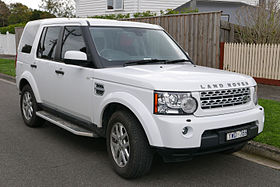
Pre-facelift Land Rover Discovery 4 |
|
| Overview | |
| Also called | Land Rover LR4 (North America & the Middle East) |
| Production | 2009–2016 |
| Assembly | United Kingdom: Solihull (Solihull plant) Jordan: Aqaba (Aqaba plant) |
| Designer | Gerry McGovern (2007) |
| Body and chassis | |
| Body style | 5-door estate |
| Related | Range Rover Sport (L320) |
| Powertrain | |
| Engine | 3.0 L AJ126 V6-S (petrol) 5.0 L AJ133 V8 (petrol) 2.7 L AJD V6-T (diesel) 3.0 L AJD V6-T (diesel) |
| Transmission | 6-speed ZF manual 6-speed ZF automatic 8-speed ZF automatic |
| Dimensions | |
| Wheelbase | 2,885 mm (113.6 in) |
| Length | 4,838 mm (190.5 in) |
| Width | 2,022 mm (79.6 in) (mirrors folded) |
| Height | 1,970 mm (77.6 in) (including roof rails) |
| Curb weight | 2,396–2,583 kg (5,282–5,695 lb) |
The Discovery 4 (called the LR4 in North America and the Middle East) is an updated version of the Discovery 3.[19]
Using the same Integrated Body Frame structure, the new Discovery has altered front and rear light units and a restyled front grille and bumper to adopt the same smoother, rounder style as also adopted for the 2010 Range Rover and Range Rover Sport.[20] The Discovery 4 also retains the body-coloured wheel arches and bumpers as the late Discovery 3s (early D3s had black plastic trim). Optional Daylight Running Lamps can be specified whilst LED lights feature prominently in both front and rear lamp units.
Pre-facelift Discovery 4 TDV6 (Australia)
Facelift Discovery 4 HSE (Europe)
Facelift Discovery 4 TDV6 (Australia)
Interior
The majority of the changes are mechanical, with reliability issues addressed, improvements to engines and gearboxes, brake and suspension refinements, but also included major interior upgrades with a more luxurious and contemporary interior with greater luxury and technology levels available. The D4 receives two engines from Jaguar Land Rover’s Gen III range. The TDV6 Gen III is a 3.0-litre development of the 2.7-litre engine used in the D3. The new version features advanced twin-sequential turbochargers where a Variable geometry turbocharger is used at low engine speeds, with a second standard turbo is brought online at higher engine speeds.[21] Two versions of the 3.0-litre diesel are offered. Fuel economy was improved over the previous generation diesel while power, torque and diesel NVH were improved significantly. This system provides greater output than the older engine, with 241 bhp (180 kW) and 600 N⋅m (440 lb⋅ft) whilst reducing CO2 emissions by 10 percent when first introduced and in 2014 increased to 188 kW (252 hp). The Gen III version of the V8 petrol engine (available in markets outside the UK such as North America, Russia, Japan, Australia, and some EU countries) is now a 5-litre unit with Direct Petrol Injection developing 385 bhp (287 kW) and 520 N⋅m (380 lb⋅ft).[22]
An improved version of the ZF six-speed automatic/sequential gearbox was incorporated and in 2012 (2014 in the US) was further improved including a change to 8 speeds. It includes taller gearing to take advantage of the new engines’ greater torque output and an updated lock-up system to further reduce fuel consumption. Other technical changes include the fitting of the more powerful brakes from the Range Rover Sport and thicker anti-roll bars to improve on-road handling. The Stability Control System now includes a programme that detects the onset of understeer and applies the brakes. The Discovery 4 retains its predecessor’s fully independent air suspension with cross-linking when off-road and the twin-range transfer gearbox with an electronic infinitely variable locking centre differential.[23] As before, a similar locking rear differential is available. The Terrain Response system remains but with two new features – the ‘Sand’ mode incorporates a new traction control mode to prevent loss of traction when starting off and stopping in soft sand, and the ‘Rock Crawl’ mode gains a feature that applies gentle brake pressure at low (less than walking pace) speeds to improve grip and stability on slick rock. The system is also ‘retuned’ to account for the new engines and gearboxes with their different torque characteristics. Other new electronic systems include Trailer Stability Assist which can adjust the throttle and brakes to prevent a dangerously swaying trailer.[24]
The 2.7-litre TDV6 engine was available in Europe on the basic 2.7 GS passenger and 2010 Commercial ranges. Unlike the Discovery 3 base model, this was equipped with air suspension and the Terrain Response system. The automatic gearbox was an option on this model. The 3.0-litre Gen III model (only with automatic gearbox) is also available in the GS trim level.
The Discovery 4 also features a redesigned interior (in keeping with the new styles introduced elsewhere in the LR range for 2010). The instrument cluster is updated with redesigned analogue speedometer and tachometer gauges for improved clarity. The analogue temperature/fuel gauges of the previous model and the electronic information display are replaced by a single TFT screen capable of displaying information in a variety of modes and formats. The interior also has a new centre console, which includes redesigned and simplified switches and controls.[25] The Discovery also has a new seat design and a wider range of available interior materials – some previously only seen in Range Rover models. The stated aim of the interior redesign was to lift the vehicle upmarket, with higher-spec models now aimed at the luxury and executive markets.[25]
The car gains some electronic systems from the Range Rover lineup, such as the optional ‘Surround Camera System’ – a series of cameras located in the front bumper, door mirrors, and rear tailgate handle which can display their images on the centre console screen to improve visibility (although the image quality of this system was downgraded by Land Rover around 2014). Other electronic systems are intended to improve efficiency – the engines feature a ‘Smart’ alternator that only charges the battery when engine load is low, thus helping to reduce fuel consumption when the engine is working harder.[26]
The Discovery 4 was unveiled in the summer of 2009 and went on sale in the United Kingdom on 1 September that year. A Commercial van variant was released in the UK at the same time using the 2.7 engine and offered in GS and XS trim levels. In the Republic of Ireland a Commercial van was offered from 1 January 2010 based on the XE 2.7 manual and HSE 3.0 auto engines.
An armoured Discovery with B6 ballistic level of protection was announced in 2010. It offers numerous safety features designed to protect the occupants, including protection from grenades and small arms fire. The vehicle is indistinguishable from the standard LR4.[27][28]
For the 2011 model year announced late 2010, the 2.7-litre engine was dropped and two versions of the 3.0-litre engine were made available – one called the TDV6 and one called the SDV6 (the latter offering 245 bhp).
For the 2012 model year, diesel models in Europe came with the new eight-speed auto gearbox with steering wheel paddle controls and a circular dial selector that raises upon startup. The SDV6 engine was uprated to 255 bhp (190 kW) whilst both diesel engines featured reduced emissions for European models. During 2012 the HSE Luxury special edition was announced, featuring enhanced trim levels, and available in Europe and North American markets.[29]
In Ireland, 2012 saw the introduction of a new five-seat version of the Discovery 4 classified as an N1 Commercial vehicle, therefore attracting lower VRT rates. There is also a new two-seat Commercial on the same rules. All Irish models came with the lower emissions TDV6 engine. In 2014, an enhanced version of the unique-to-Ireland five-seater commercial utility went on sale which included almost all top-of-the-range features for a lower price. This vehicle is now the top selling Discovery in Ireland due to the fact that it attracts low road tax (€333 per year) and VAT can be reclaimed.
For 2013, models received a style freshening, new badging, new fuel stretching technology, improved audio systems and a new range of driver assistance, comfort and safety features. The 2014 Discovery comes with a standard ZF 8HP transmission, and in some markets can be supplied with a one-speed transfer case (replacing the two speed transfer case). 2014 also marks the first use of a 2,995 cc (2.995 L; 182.8 cu in) supercharged six cylinder engine, replacing the previous V6 and V8 offerings.
In a January 2011 comparison test by Car and Driver, the Land Rover LR4 came in fourth place out of five cars behind the Audi Q7, BMW X5, and Acura MDX.[30] However, it has always won the Auto Express categories of Best Large SUV and Best Towcar since it was launched in 2009.[31]
To celebrate 25 years of the Land Rover Discovery, a special edition of 1800 (?) vehicles was produced in 2014 marked as the XXV, and featured a number of unique details including light grey (Cirrus) XXV-embossed Windsor leather seats, special grill sets, and almost every extra and expansion pack available. A number of these were exported in silver grey and the darker causeway grey for UK markets.
A major milestone in Land Rover Discovery’s history came when the one millionth example built rolled off the Solihull production line in March 2012. This vehicle, along with two similar examples, was driven from Solihull to Beijing, China in a replication of a 1950s expedition. During this expedition, G459 WAC, a pre-production Discovery 1 (which was subsequently converted into an amphibious vehicle) joined in the celebrations when the expedition visited Lake Geneva. The expedition concluded with the actual Millionth Discovery appearing at the Beijing Motor Show. This vehicle subsequently returned to go on permanent exhibition at the British Motor Industry Heritage Trust centre at Gaydon, Warwickshire, England.[32]
- Engines
| Model | Years | Type/code | Power, torque at rpm |
|---|---|---|---|
| Petrol engines | |||
| 5.0 L V8 | 2009 (MY2010)-2013 | 4,999 cc (4.999 L; 305.1 cu in) V8 32v (AJ133) | 375 PS (276 kW; 370 hp) at 6,500, 510 N⋅m (376 lb⋅ft) at 3,500 |
| 3.0 L SCV6 | 2014– | 2,995 cc (2.995 L; 182.8 cu in) V6 supercharged (AJ126) | 340 PS (250 kW; 335 hp) at 6,500, 460 N⋅m (339 lb⋅ft) at 3,500–5,000 |
| Diesel engines | |||
| 2.7 L TDV6 | 2009–2010 | 2,720 cc (2.72 L; 166 cu in) V6 single turbo (Ford AJD-V6/PSA DT17) | 190 PS (140 kW; 187 hp) at 4,000, 440 N⋅m (325 lb⋅ft) at 1,900 |
| 3.0 L TDV6 | 2011–2013 | 2,993 cc (2.993 L; 182.6 cu in) V6 twin turbo (Ford AJD-V6/PSA DT20) | 211 PS (155 kW; 208 hp) at 4,000, 520 N⋅m (384 lb⋅ft) at 2,000 |
| 3.0 L SDV6 | 2009–2011 | 2,993 cc (2.993 L; 182.6 cu in) V6 twin turbo (Ford AJD-V6/PSA DT20) | 245 PS (180 kW; 242 hp) at 4,000, 600 N⋅m (443 lb⋅ft) at 2,000 |
| 3.0 L SDV6 | 2011–2013 | 2,993 cc (2.993 L; 182.6 cu in) V6 twin turbo (Ford AJD-V6/PSA DT20) | 258 PS (190 kW; 254 hp) at 4,000, 600 N⋅m (443 lb⋅ft) at 2,000 |
- Transmissions
| Model | Years | Type/code |
|---|---|---|
| Petrol engines | ||
| 5.0 L V8 | 2009–2013 | ZF 6HP28 6-speed automatic |
| 3.0 L SCV6 | 2014– | ZF 8-speed automatic |
| Diesel engines | ||
| 2.7 L TDV6 | 2009–2010 | ZF S6-53 6-speed manual, ZF 6HP26 6-speed automatic |
| 3.0 L TDV6 | 2009–2013 | ZF 6HP28 automatic |
| 3.0 L SDV6 | 2012–2016 | ZF 8HP70 automatic |
Third generation (L462; 2017–present)[edit]
| Third generation (L462) | |
|---|---|
 |
|
| Overview | |
| Production | 2017–present |
| Assembly | United Kingdom: Solihull (Solihull plant 2017–2018) Slovakia: Nitra (Jaguar Land Rover Slovakia s.r.o. 2018–present) |
| Designer | Gerry McGovern[33] |
| Body and chassis | |
| Body style | 5-door SUV |
| Platform | JLR D7u[34] |
| Related |
|
| Powertrain | |
| Engine | 3.0L AJ126 V6 Supercharged (petrol) 3.0L AJD-V6 turbodiesel 2.0L Ingenium AJ200D turbodiesel 2.0L Ingenium AJ200 turbocharged I4 (petrol) 3.0 L Ingenium AJ300 turbocharged I6 (petrol) MHEV 360ps (355 hp) |
| Transmission | 8-speed ZF automatic |
| Dimensions | |
| Wheelbase | 2,923 mm (115.1 in) |
| Length | 4,970 mm (195.7 in) |
| Width | 2,000 mm (78.7 in) (body) 2,073 mm (81.6 in) (mirrors folded) |
| Height | 1,888 mm (74.3 in) |
| Kerb weight | 2,193 kg (4,835 lb) (petrol) 2,230 kg (4,916 lb) (diesel) |
The third-generation Discovery was unveiled in the grounds of Packington Hall near Meriden, UK on 28 September 2016, the eve of the 2016 Paris Motor Show, and went on sale in the UK in February 2017.[35][36][37] Built on a platform shared with the Range Rover and Range Rover Sport, the current Discovery leaves behind many of the design traditions of former generations for a more modern, though less overtly practical, design. This model also marks the return of the Discovery marque in the U.S. market, replacing the LR moniker of the previous generation models.[38] There are five-seat, seven-seat, and commercial van versions in the UK, Ireland and other European markets. In November 2020, a facelift for the model was launched, which debuted as a 2021 model.
This is the first Discovery that will be manufactured outside the UK, with production being moved to Slovakia in 2019.[39]
A Discovery 3.0 TD6 achieved an AIR Index emission rating of «A» (A=Best, E=Worst) when independently tested in 2019.[40]
The SVX version was debuted on Frankfurt motor show 2017, the car was to be on sale in 2019 but the project was cancelled.[41]
Discovery HSE Td6
Interior
Design[edit]
The design of the third-generation Discovery was previewed by the Discovery Vision Concept at the 2014 New York Auto Show. In profile, the exterior design is also very similar to the small Discovery Sport model. In contrast to previous Discovery models, the third-generation has a much more rounded shape, eschewing the traditional angular design. The tail lights have changed from a vertical orientation to horizontal, and the third-row side glass no longer blends into the roof glass. The tailgate is no longer horizontally split and has been replaced with a conventional top hinged tailgate made from composite, but retaining the asymmetrically mounted license plate as a design cue from previous generations of the Discovery. The roof is still stepped over the third row, though it is now largely cosmetic in comparison to the previous models and the roof now has a strong taper to the back. The interior closely follows that from other contemporary Land Rover models, while continuing the 3-row tradition of the Discovery.
Mechanical[edit]
The new Discovery 5 incorporates several changes over its predecessors. For the first time, the Discovery is based on Land Rover’s aluminium architecture, first introduced on the Range Rover (L405). The use of aluminium chassis and body panels gives a weight loss of up to 480 kg over its predecessor. This weight loss combined with a new aerodynamic design, a 17 percent lower Cd, achieves a fuel efficiency improvement over previous Discovery generations. The new Discovery is offered with a combination of V6 petrol and diesel engines. All Discovery 5s are equipped with a standard 8 speed automatic transmission. An available option package adds a two speed transfer case (low range gearbox) and the option of an actively locking rear differential. Coil springs are now standard on base trim models, while air suspension is still offered as an option.
Land Rover also introduces Terrain Response 2 on the Discovery 5. Similarly to the first generation of Terrain Response, Terrain Response 2 constantly monitors wheel slip, wheel speed, angle of approach or departure, and the suspension’s compression or rebound to adjust the anti-lock braking system, throttle response, differentials and traction control systems. The driver can select modes for snow, grass, gravel, mud ruts, sand, or rock crawling by the spin of a dial on the centre console. Terrain Response 2 also introduces a new ‘Auto’ mode that allows the vehicles computer to select the most appropriate mode on its own.
The Discovery 5 is the first Discovery to be built on a unibody chassis, unlike its predecessors which were built body on frame. This allows the vehicle to have higher torsional rigidity with less weight. According to the automotive press,[who?] the latest generation has a higher wading depth (up to 35.6 inches (90 cm)), improved ground clearance and a more comfortable ride while traversing adverse terrain.
A mid term update with a refreshed interior and new engine range was launched in 2021. Larger infotainment screens and revisions to the layout of the Commercial variant including more underfloor storage were the main highlights. Mild hybrid engines with automatic 2WD/4WD switching was now introduced as standard across the range.
Derivatives and specialist versions[edit]
Discovery 4 Sentinel at DSEi 2015
Supacat’s LRV 400 Mk2 is based on the Discovery 4
Supacat, part of SC Group, offer two vehicles based on a modified Discovery 4 platforms. The Specialist Utility Vehicle 600 (SUV 600) is a production standard Land Rover Discovery 4 that is converted to 6×6 or 6×4 configuration for use in the emergency services and wider utility sectors. The Light Reconnaissance Vehicle 400 (LRV 400) is an open lightweight 4×4 vehicle of the Land Rover Defender class. The LRV 400 was developed based on a combination of market research and customer feedback from the 2011-unveiling of a proof-of-concept closed cab variant. Development of the LRV 400 continues, the latest Mk2 shown publicly for the first time at DSEI 2015 (15–18 September). The most significant design change for the Mk2 is a switch of the automotive platform to the Land Rover Discovery 4 rather than the off-road racer platform previously offered.[42]
Land Rover offered an armoured version of the Discovery 4, the Sentinel. Protected to Level B6 (defined in accordance with European Standard EN1063 BR6 (glazing) and EN1522 and certified by QinetiQ), according to Jaguar Land Rover the Discovery 4 Sentinel is almost indistinguishable from the non-armoured Discovery 4. As a factory supplied product the vehicle comes with a Land Rover three-year or 50,000 miles (80,000 km) warranty, the support of Land Rover’s worldwide dealer network and a range of additional after sales packages.[43] The UK Government ministers are often seen ferried around in Discovery 4 Sentinels.
A great number of Land Rover Discovery II and IV were bought and used by Italian Police and Carabinieri. The vehicles were configured with reinforced iron grating on mirrors and windshields, fire-extinguishing automatic system and run-flat tyres, for crowd and riot control operations.
The 30th Anniversary[edit]
2019 saw the 30th Anniversary of the launch of the Land Rover Discovery. A special edition model was released. Celebratory events took place across the world. The new JLR plant in Slovakia had the capacity to produce up to 300,000 Discovery units per year. In Ireland the Discovery range, including the Commercial, was fully aligned with that of the UK.
Worldwide sales[edit]
As of 1 January 2017, some 1,200,000 Discovery models had been sold in total since launch in 1989.
Total sales are for 2009 and onward, excluding sales prior to that year.
| Year | Sales |
|---|---|
| 2009 | 32,331 |
| 2010 | 38,743 |
| 2011 | 44,874 |
| 2012 | 46,252 |
| 2013 | 45,898 |
| 2014 | 45,080 |
| 2015 | 51,008 |
| 2016 | 49,428 |
| Total | 353,614 |
[44]
Motorsport[edit]
A Discovery won the Rallye Aicha des Gazelles in 2010.
References[edit]
- ^ a b «30 years of the Land Rover Discovery – celebrating Britain’s unsung design icon». The Telegraph.co.uk. Retrieved 9 December 2019.
- ^ Taylor, James (2014). Land Rover Discovery: 25 Years of the Family 4 x 4. The Crowood Press UK. ISBN 978-1847976895.
- ^ a b c History of the Land Rover Discovery: Release – Land Rover San Antonio
- ^ a b c d e f «Land Rover Discovery (Discovery Mk1)». GoAuto. Retrieved 11 August 2016.
- ^ «Land Rover Discovery – Used Car Research». GoAuto. Retrieved 11 August 2016.
- ^ «1994–1998 Land Rover Discovery: Overview – Consumer Guide Automotive». Auto.consumerguide.com. Archived from the original on 25 December 2006. Retrieved 14 July 2009.
- ^ a b c d e f g h i j k l m n o Taylor, James (1999). Land Rover Discovery 1989–1998. Motor Racing Publications Ltd. ISBN 1899870-40-7.
- ^ «Mellow Yellow». Rovers Magazine. 13 November 2017. Retrieved 17 April 2019.
- ^ «Land Rover Malaysia Sets Up Website». autoworld.com.my. 24 July 2001. Archived from the original on 18 May 2015. Retrieved 18 May 2015.
- ^ Land Rover Discovery II: 8 Reasons to Buy One Today – Dust Runners Automotive Journal
- ^ The History of Land Rover – iFixit
- ^ «Active Cornering Enhancement — ACE». Cars-Data.com. Retrieved 15 November 2019.
- ^ Land Rover publication LRML1987/03 of 2003
- ^ «The NEC starts you can’t afford to miss». Auto Express. 808: 45. 25 May 2004.
- ^ «MOST Cooperation». MOST Cooperation. Archived from the original on 18 May 2009. Retrieved 12 November 2011.
- ^ Weston, Peter. «Peter Weston». LinkedIn.
{{cite web}}: CS1 maint: url-status (link) - ^ «Ford to start assembly line in Russia». UPI. 20 August 2001. Retrieved 5 September 2021.
{{cite web}}: CS1 maint: url-status (link) - ^ Belfiore, Michael (4 November 2007). «Carnegie Takes First in DARPA’s Urban Challenge». Wired.
- ^ «Land Rover Discovery Model». ReiCars.com. Archived from the original on 1 February 2016. Retrieved 8 January 2015.
- ^ Land Rover D4 brochure, p.5
- ^ Land Rover D4 brochure, p.14
- ^ Land Rover D4 brochure, p.14 + p.34
- ^ Land Rover D4 brochure, p.22 + p.23
- ^ Land Rover D4 brochure, p.17
- ^ a b Land Rover D4 brochure, p.6
- ^ Land Rover Discovery brochure, p.15
- ^ «Jaguar and Land Rover Armoured Vehicles». Governmentbusiness.co.uk. Archived from the original on 23 July 2011. Retrieved 3 December 2010.
- ^ «Discovery 4 Sentinel» (PDF). Security Systems Tech. Retrieved 8 April 2014.
- ^ Land Rover D4 Brochure 2012 Europe
- ^ «Acura MDX vs. Audi Q7 3.0T, BMW X5 xDrive35i, Land Rover LR4 HSE, Lexus GX460». 18 March 2021.
- ^ «JLR Corporate Homepage International». media.jaguarlandrover.com. Retrieved 6 December 2018.
- ^ «Land Rover Launches Journey of Discovery». Newsroom.jaguarlandrover.com. Retrieved 23 March 2012.
- ^ «Gerry McGovern — Unstoppable Spirit — Land Rover UK». www.landrover.co.uk. Retrieved 6 December 2018.
- ^ Burgess, Rachel (20 April 2018). «Baby SUVs to spearhead new Land Rover offensive». Autocar. Retrieved 30 November 2018.
- ^ McIlroy, John (29 September 2016). «New Land Rover Discovery 2017: prices, specs, pictures and full details». Auto Express. Dennis Publishing. Retrieved 29 September 2016.
- ^ «New Land Rover Discovery unveiled by Bear Grylls during star-studded event». Coventry Telegraph. Trinity Mirror Midlands. 29 September 2016. Retrieved 14 October 2016.
- ^ McIlroy, John (10 February 2017). «New 2017 Land Rover Discovery: prices, specs and everything you need to know». Auto Express. Retrieved 13 April 2017.
- ^ Paukert, Chris (28 September 2016). «Land Rover’s reborn Discovery wades in with off-road ability, upscale family smarts». CNET. Retrieved 16 November 2016.
- ^ «Land Rover moves Discovery model out of UK». BBC News. 11 June 2018. Retrieved 11 June 2018.
- ^ «Air Index launches on-road, independent guide to tailpipe emissions». FleetNews. 28 February 2019. Retrieved 7 March 2019.
- ^ «It Looks Like the Land Rover Discovery SVX is Dead». 15 February 2019.
- ^ «Supacat Unveils Latest LRV 400 Recon Vehicle». Retrieved 20 September 2015.
- ^ «Discovery 4 Sentinel». Archived from the original on 8 December 2015. Retrieved 20 September 2015.
- ^ «Archived copy». Archived from the original on 31 July 2017. Retrieved 13 August 2017.
{{cite web}}: CS1 maint: archived copy as title (link)
External links[edit]
- Official website (UK)
- Official website (U.S.)
- Official website (MENA)
- [1]
(CAN)
- Official website (Special Vehicle Operations)
Discovery третьего поколения, несмотря на необычный внешний вид, сохранило «бойцовские» качества своих легендарных предшественников — участников множества ралли-рейдов и экспедиций
Land Rover Discovery
Общие сведения об автомобиле
Land Rover Discovery – среднеразменый внедорожник с переднемоторной компоновкой и полным приводом. Третье поколение производилось на заводе компании в Великобритании с 2004 по 2009 год.
В Соединенных Штатах Америки автомобиль продавался под названием Land Rover LR3.
История создания
В 2004 году автомобиль появился в Северной Америке под индексом LR3, спустя полгода Land Rover Discovery третьего поколения поступил в продажу в Европе, и только в 2005-м внедорожник добрался до России.
При создании третьего поколения Land Rover Discovery планировалось, что внедорожник займет нишу между утилитарным Land Rover Defender и премиальным Range Rover, но при этом по уровню оснащения и комфорта будет приближен к последнему.
Автомобиль построен на базе Range Rover, и имеет прочную раму, интегрированную в силовой каркас кузова – эта технология получила название Body-Frame – благодаря ей удалось увеличить жесткость кузова на кручение и в значительной степени улучшить управляемость. Автомобиль производился вплоть до 2009 года, пока его не сменила четвертая генерация Land Rover Discovery.
Технические особенности
Полноприводная трансмиссия третьего поколения Land Rover Discovery оборудована блокируемой межосевой муфтой и блокируемым задним дифференциалом. В базовой версии «S» автомобиль оборудован дизельным мотором, который работает в паре с механической коробкой передач, и пружинной подвеской. В топовой же комплектации муфта и дифференциал блокируются электронной системой Terrain Response с 5-ю запрограммированными режимами. В зависимости от выбранного режима (нормальное покрытие, трава/гравий/снег, грязь/рытвины, песок, камни) система изменяет высоту пневмоподвески, меняет алгоритм и периодичность блокировки дифференциалов, предупреждает водителя о необходимости включить пониженную передачу, а также изменяет настройки привода газа, антиблокировочной и антипробуксовочной систем. Понижающую передачу на внедорожнике можно включить при скорости движения до 40 км/ч, при этом на дисплее появляется изображение, информирующее о том, в какую сторону повернуты передние колеса. Кроме того, на этот дисплей выводится вся информация о работе трансмиссии и выбранном режиме.
Максимальный дорожный просвет у Land Rover Discovery составляет 25 сантиметровм (в положении Off Road), при этом, если электронная система решит, что этого недостаточно, автомобиль «приподнимется» еще на 7 сантиметров.
Третье поколение Discovery может оснащаться дизельным 2.7-литровым мотором – по сравнению с предыдущим поколением внедорожник с таким двигателем потребляет на 10% меньше топлива. Для наибольшей экономичности была применена инновационная технология прямого впрыска топлива, вместо насоса-форсунки с электронным управлением, который был установлен на Land Rover Discovery II.
В сравнении с одноклассниками
Один из основных козырей Discovery III — дизельный мотор, который пользуется большей популярностью, чем бензиновый и, соответственно, преобладает на вторичном рынке. Он был разработан совместно с концерном PSA Peugeot Citroen, а его ресурс составляет порядка 500 тысяч километров.
Также внедорожник отличается надежной ходовой частью, в конструкции которой — полностью независимая подвеска на двойных поперечных рычагах спереди и сзади.
От многих конкурентов Land Rover Discovery отличает то, что задний диван разделен на три отдельных кресла, при этом центральное сидение – вполне полноценное, а не «половинчатое», как на многих других внедорожниках. В 7-местном исполнении третий ряд сидений также отличается комфортабельностью – он отнюдь не «детский». С посадкой на третий ряд тоже проблем не возникает- спинки кресел второго ряда откидываются таким образом, что не затрудняют проход.
Интересные факты
В процессе разработки Discovery 3 семьдесят пять опытных образцов тестировались во всех уголках земного шара в разных температурных условиях: от −30С до +50C.
В 2008 году компания Land Rover отметила свою 60-ую годовщину. В связи с этим 60 внедорожников этой марки были переданы Британскому Обществу Красного Креста и сотрудничающим с ним национальным обществам по всему миру. Среди этих автомобилей было и несколько экземпляров Discavery III.
Автоспорт
Внедорожник третьего поколения не принимал участия в профессиональных автоспортивных мероприятиях, хотя широко использовался для выступлений в любительских ралли-рейдах и пробегах. Однако эта модель имеет автоспортивную историю – первый Land Rover Discovery принимал участие в знаменитом ралли Camel Trophy в 90-х годах.
Цифры и награды
За пять лет было произведено более 220 000 экземпляров Discovery третьего поколения.
- Лэндровер
-
Технич.информация DISCOVERY 3
| Технические параметры | 2,7L Турбодизель с МКПП | 2,7L Турбодизель с АКПП | 4,4L Бензин с АКПП |
| Кузов | |||
|---|---|---|---|
| Тип | универсал | универсал | универсал |
| Количество дверей | 5 | 5 | 5 |
| Число мест | 5 или 7 | 5 или 7 | 5 или 7 |
| Двигатель | |||
| Тип | Дизель с турбонадувом | Дизель с турбонадувом | Бензин, впрыск |
| Рабочий объем, см2 | 2720 | 2720 | 4394 |
| Число и расположение цилиндров | 6 цилиндров, V-образное | 6 цилиндров, V-образное | 8 цилиндров, V-образное |
| Максимальная мощность, л.с. | 195 | 195 | 295 |
| Максимальный крутящий момент, Нм | 440 | 440 | 425 |
| Максимальная скорость, км/ч | 180 | 180 | 195 |
| Разгон с места до 100 км/ч, сек. | 11.5 | 12.8 | 8.6 |
| Расход топлива в загородном цикле, л/100км | 8.2 | 8.7 | 11.6 |
| Расход топлива в смешанном цикле, л/100км | 9.4 | 10.4 | 15 |
| Расход топлива в городском цикле, л/100км | 11.5 | 13.2 | 20.9 |
| Емкость топливного бака, л | 82.3 | 82.3 | 86.3 |
| Трансмиссия | |||
| Тип привода | полный | полный | полный |
| Тип КПП | механическая | автоматическая Steptronic | автоматическая Steptronic |
| Кол-во передач | 6 | 6 | 6 |
| Ходовая часть | |||
| Тип передней подвески | независимая | независимая | независимая |
| Тип задней подвески | независимая | независимая | независимая |
| Передние тормоза | дисковые вентилируемые | дисковые вентилируемые | дисковые вентилируемые |
| Задние томоза | дисковые | дисковые | дисковые |
| Габариты и размеры | |||
| Длина, мм | 4835 | 4835 | 4835 |
| Ширина, мм | 2190 | 2190 | 2190 |
| Высота, мм | 1920 (с откр. Люком) | 1920 (с откр. Люком) | 1920 (с откр. Люком) |
| Дорожный просвет, мм | 18-28.5 | 18-28.5 | 18-28.5 |
| Колесная база, мм | 2885 | 2885 | 2885 |
| Глубина водного препятствия, мм | 700 (c пневмо подвеской) | 700 (с пневмо подвеской) | 700 (с пневмо подвеской) |
| Весовые характеристики | |||
| Масса снаряженного автомобиля, кг | 2494 | 2504 | 2536 |
| Максимально допустима масса, кг | 3230 | 3230 | 3230 |
| Масса прицепа не оснащенного тормозами, кг | 750 | 750 | 750 |
| Масса прицепа оснащенного тормозами, кг | 3500 | 3500 | 3500 |
На графике, зависимость скорости движения на различных передачах от оборотов даигателя (V8, 4,4L)
| Land Rover Discovery3 2.7 TDV6 5 дверей | |
|---|---|
| Стандартная комплектация | Версия «S» |
| Независимая пружинная подвеска | |
| 6-ти скоростная механическая коробка передач | |
| 2-х ступенчатая раздаточная коробка электронного типа | |
| 17″ литые диски (4 шт.) + 1 стальное | |
| Блокировка центрального межосевого дифференциала | |
| 2-х створчатая крышка багажного отделения | |
| Блокировка центрального замка при начале движения | |
| Центральный замок | |
| Датчики объема | |
| Электронный ручной тормоз | |
| Фронтальные и боковые занавесы безопасности | |
| Подстаканники в центральной части консоли и задней части автомобиля | |
| Механическая регулировка водительского сидения по высоте и по длине | |
| Антипробуксовочная система (EBD, ABS, ETC) + HDC | |
| Складывающиеся задние сидения (60/40) | |
| Электропакет всех стекол | |
| Электрически регулируемые зеркала с подогревом | |
| Кондиционер | |
| Пакет курильщика (пепельница + прикуриватель) | |
| Центральный разделительный подлокотник в заднем сидении | |
| Магнитола CD + радио, 6 динамиков | |
| Система стабилизации курсовой устойчивости автомобиля (DSC) | |
| Датчик непристегнутого ремня | |
| Датчик угла наклона автомобиля | |
| Шторка багажного отделения складная | |
| Электронная система помощи при экстренном торможении | |
| Третий стоп-сигнал | |
| Антикреновая система поперечной устойчивости | |
| Боковые подушки безопасности для задних пассажиров | |
| Система дополнительного подогрева двигателя | |
| Дополнительно для версии «SE» | |
| Пневмоподвеска | |
| 18″ литые диски | |
| Автоматический двухзонный (лев.-прав.) климат-контроль | |
| Задние парктроники | |
| Передние и задние брызговики | |
| Би-ксенон | |
| Пакет «Trip and interior lighting pack»: бортовой компьютер, сопровождающее освещение | |
| Пакет «Bright pack»: передние противотуманки, автоматическая регулировка передних фар, фароомыватель высокого давления, датчик дождя, самозатемняющееся зеркало |
|
| Дополнительно для версии «HSE» | |
| Боковые подушки безопасности для задних пассажиров | |
| Круиз-контроль | |
| Пакет «Hi Ice Pack»: 8 динамиков, сабвуфер, динамики для акустической системы Harman Kardon, управление магнитолой на руле, интегрированный CD-changer (6 дисков) |
|
| Пакет «Convenience pack»: складывающийся задний ряд сидений (35:30:35), косметические зеркала с подстветкой, сетка багажного отделения, подстаканники для третьего ряда сидений |
|
| Пакет «Leather Pack»: кожаные сидения с подлокотником для водителя, кожаная отделка рычага КПП, электрическая регулировка водительского сидения с памятью (8 положений), электрическая регулировка пассажирского сидения (6 положений) |
|
| Дополнительные опции | для версии «S» |
| Литые диски Style 2 19″ | |
| Полноразмерное запасное колесо | |
| 6-ти ступенчатая автоматическая коробка передач | |
| 4-х уровневая пневмо-электронная подвеска с системой Terrain Response | |
| Задний дифференциал с эл. управлением (только с 027BY) | |
| Электрически складывающиеся зеркала | |
| Круиз-контроль | |
| Электрический люк + «прозрачная» крыша в задней части кузова | |
| Датчики удара сигнализации | |
| Автоматический двухзонный (лев.-прав.) климат-контроль | |
| Окраска кузова металлик | |
| Пакет «7 seats»: подушки безопасности, розетка в багажном отделении, складные задние сидения, подсветка |
|
| Пакет «Tow pack»: фаркоп | |
| Пакет «Convenience pack»: складывающийся задний ряд сидений (35:30:35), косметические зеркала с подстветкой, сетка багажного отделения, подстаканники для третьего ряда сидений |
|
| Пакет «Cold climate pack»: подогрев переднего стекла, подогрев сидений, подогрев форсунок омывателя |
|
| для версии «SE» | |
| Литые диски Style 2 19″ | |
| Полноразмерное запасное колесо | |
| 6-ти ступенчатая автоматическая коробка передач | |
| Задний дифференциал с эл. управлением | |
| Передние парктроники | |
| Электрические складывающиеся зеркала | |
| Рельсы на крыше | |
| Круиз-контроль | |
| Электрический люк + «прозрачная» крыша в задней части кузова | |
| Датчики удара сигнализации | |
| Кондиционер/печка для задних пассажиров | |
| Навигационная система | |
| Премиум навигационная система | |
| Адаптивные поворотные фары | |
| Охлаждаемый бокс между передними сидениями | |
| Отделка под темное дерево | |
| Порт для подключения телефона | |
| Окраска кузова металлик | |
| Пакет «7 seats»: подушки безопасности, розетка в багажном отделении, складные задние сидения, подсветка |
|
| Пакет «Tow pack»: фаркоп | |
| Пакет «Convenience pack»: складывающийся задний ряд сидений (35:30:35), косметические зеркала с подстветкой, сетка багажного отделения, подстаканники для третьего ряда сидений |
|
| Пакет «Cold climate pack»: подогрев переднего стекла, подогрев сидений, подогрев форсунок омывателя |
|
| Пакет «Hi Ice Pack»: 8 динамиков, сабвуфер, динамики для акустической системы Harman Kardon, управление магнитолой на руле, интегрированный CD-changer (6 дисков) |
|
| для версии «HSE» | |
| Литые диски Style 2 19″ | |
| Полноразмерное запасное колесо | |
| 6-ти ступенчатая автоматическая коробка передач | |
| Задний дифференциал с эл. управлением | |
| Передние парктроники | |
| Электрические складывающиеся зеркала | |
| Тонировка стекол задней части кузова | |
| Рельсы на крыше | |
| Электрический люк + «прозрачная» крыша в задней части кузова | |
| Датчики удара сигнализации | |
| Кондиционер/печка для задних пассажиров | |
| Навигационная система | |
| Премиум навигационная система | |
| Адаптивные поворотные фары | |
| Охлаждаемый бокс между передними сидениями | |
| Отделка под темное дерево | |
| Порт для подключения телефона | |
| Окраска кузова металлик | |
| Пакет «7 seats»: подушки безопасности, розетка в багажном отделении, складные задние сидения, подсветка |
|
| Пакет «Tow pack»: фаркоп | |
| Пакет «Cold climate pack»: подогрев переднего стекла, подогрев сидений, подогрев форсунок омывателя |
|
| Пакет «Premium Ice Pack»: 13 динамиков: Harman Kardon Logic 7, сабвуфер, DSP антенна, модуль для наушников в задней части автомобиля, управление магнитолой на руле, CD-changer на 6 дисков фронтальной загрузки |
|
| Цвета кузова | Chawton White Solid Белый |
| Bonatti Grey Темно серый (металлик) | |
| Alveston Red Вишневый (микаталлик) | |
| Java Black Черный (перламутр) | |
| Adriatic Blue Темно синий (металлик) | |
| Zambesi Silver Серебристый (металлик) | |
| Vienna Green Оливковый (микаталлик) | |
| Belize Green Solid Темно зеленный (не металлик) | |
| Cairns Blue Темно синий (металик) | |
| Tonga Green Темно серо-зеленый( мет) | |
| Тип и отделка салона | Tundra Cloth Серо-зеленая ткань |
| Tundra Leather Серо-зеленая кожа | |
| Ebony Cloth Черная ткань | |
| Ebony Leather Черная кожа | |
| Alpaca Cloth Бежевая ткань | |
| Alpaca Leather Бежевая кожа |
Мы здесь
Москва, ул. Смирновская, д. 19
Copyright © 2001-2021 LRService.ru — Техцентр Land Rover, ремонт, обслуживание, тюнинг, запчасти для британских внедорожников в Москве. | Создание и продвижение сайтов — IMPERIA DIGITAL | Дизайн сайта — IMPERI.PRO.
Коленчатый вал
Санкт-Петербург возможна доставка по городу
1 ₽
Aozoom K3 dragon knight
Ярославль возможна доставка по миру
11 000 ₽
Aozoom dragon knight v2 2022
Ярославль возможна доставка по миру
1 000 ₽
Корзина лебедки с креплениями «американский квадрат».
Москва самовывоз
10 000 ₽
Показать ещё
Land Rover Discovery III TDV8 RAIDER
Land Rover Discovery 2,7 Турбо дизель
Land Rover Discovery John Silver 🇷🇺🚀
Land Rover Discovery 🔥F**k Fuel economy🔥
Санкт-Петербург, Россия
74
23
Land Rover Discovery Бродяга⚫️
Land Rover Discovery 💥Кайфовый💥
Land Rover Discovery Ведрач
Land Rover Discovery Bane
Land Rover Discovery Бродяга
Land Rover Discovery Бастион
Электросталь, Россия
65
173
Land Rover Discovery 🔴⚪️ Strongman
Land Rover Discovery Дизельный Батя
Санкт-Петербург, Россия
65
15
Land Rover Discovery 3.6 TDV8 «Танк»
Land Rover Discovery Rimini Red, V8
Land Rover Discovery III Пират Её Величества
Land Rover Discovery III, но больше чем IV
Land Rover Discovery ДИСКАРИК 🇬🇧
Land Rover Discovery
Land Rover Discovery TDV6 HSE Белый Ворон
Land Rover Discovery III SLE 22″ НЕФОРМАТ
Land Rover Discovery
Общие данные
| Годы пр-ва: | 1989—настоящее время |
Поколения
Land Rover Discovery — серия автомобилей класса внедорожник, с кузовом универсал, впервые выпущенных на рынок в 1989 году. Автомобиль занял пустующую рыночную нишу между утилитарным Land Rover Defender и роскошным Range Rover. Всего на данный момент выпущено 4 поколения. Четвёртое поколение дебютировало в апреле 2009 года на мотор-шоу в Нью-Йорке. Для рынка США получил название LR4.
История модели
Первое поколение Discovery выпускали как в 3-, так и в 5-дверном варианте. В кузове автомобиля широко использовался алюминий (из него выполнены капот, передние и задние крылья, наружные накладки на двери). На первый Discovery устанавливали бензиновые двигатели объемом 2,0 л (136 л. с.), 3,5 л (152 л. с.) и 3,9 л (182 л. с.), а также дизель объемом 2,5 л (107 л. с. — заводской индекс 200 Tdi до 1994 года включительно и 113 л. с. — заводской индекс 300 Tdi — с 1995 до 1998 года). Вместе с двигателем могла устанавливаться автоматическая или механическая коробка передач (Заводской индекс LT77 — до 1994 года и R380 — с 1995 и до 1998 года).
Land Rover Discovery первого поколения пережил две модернизации. Первая состоялась в конце 1992 года, а вторая — в конце 1994 года, в результате чего, машина получила новую головную оптику, сменилось оформление салона, а двигатель и коробка были заменены на более надежные 300Tdi и R380. Кроме того, в период с 1992 по 1995 год Discovery продавался в Японии под именем Honda Crossroad.
В 1995 году объемы производства Land Rover впервые превысили цифру 100 000 автомобилей в год. Бестселлером стал Discovery, и линейка пополнилась моделью с 2,0-литровым четырехцилиндровым бензиновым двигателем, которая позволяла владельцу воспользоваться налоговыми льготами, предусмотренными европейской системой налогообложения. Кроме того, появилась также модель Discovery с 3,9-литровым V8.
Второе поколение Land Rover Discovery появилось в 1998 году. Внешне он оказался очень похож на модели первого поколения, однако на самом деле его конструкция подверглась глобальной переработке. Например, полным приводом стала управлять электроника. Но эта модернизация не у всех поклонников нашла положительный отклик. Поэтому после модернизации автомобиля, состоявшейся в 2002 году, Discovery получил проверенные временем механические блокировки дифференциала. Discovery II обладал бензиновыми моторами V8 объемом 4,0 л (185 л. с.), 4,6 л (220 л. с.) и дизельным объемом 2,5 л (138 л. с.).
В 2004 году было представлено уже третье поколение Land Rover Discovery с независимыми подвесками. Discovery 3 обладал бензиновыми агрегатами объемом 4,0 л (V6, 219 л. с.), 4,4 л (V8, 300 л. с.) и 2,7-литровый дизелем (V6, 190 л. с.). Для модели третьего поколения была разработана система Terrain ResponseTM, которая оптимизировала настройку автомобиля для любых дорожных условий и бездорожья.
В 2009 году новое, четвертое поколение универсальных 7-местных автомобилей Land Rover получило название — Discovery 4. Самым главным достоинством Discovery 4 стал новый дизельный двигатель LR-TDV6 3,0 с двумя турбокомпрессорами, обеспечивающий снижение расхода топлива на 9 % (комбинированный цикл ЕС) и сокращение выбросов CO2 на 10 % при увеличении мощности на 29 %, по сравнению с 2,7-литровым двигателем. Показатели крутящего момента возросли ещё больше, на 36 % — до 600 Н•м — это самые высокие в мире показатели для пассажирских автомобилей с серийными 6-цилиндровыми дизельными двигателями.
Интересные факты
- 392 443 автомобиля первых поколений Discovery были выпущены за 9 лет при среднем количестве 43 604 в год. Было выпущено 278 570 автомобилей второго поколения за шесть лет (в среднем 46 428 ежегодно). В общей сложности было выпущено 220 057 автомобилей Discovery 3 за пять лет (в среднем 44 011 ежегодно), после чего им на смену пришел Discovery 4 2010 модельного года.
- Целью использования дизельных двигателей Discovery всегда была топливная экономичность. Топливная система третьего поколения в последнем 3-х-литровом двигателе TDV6 улучшила экономию топлива на 9,7 %, по сравнению с его предшественником меньшего объема двигателя на основе комбинированного EU-цикла. Инновационная система прямого впрыска топлива, используемая в двигателях TDi первого поколения Discovery, была предназначена для достижения наилучшей экономичности для данного класса машин. Для этой же цели в дизельном двигателе TD5 моделей второго поколения были использованы насос-форсунки с электроным управлением.
- В процессе разработки Discovery 3, во всех концах света в общей сложности было опробовано 75 опытных образцов, чтобы проверить всю широту возможностей этого автомобиля, заслужившего в разное время множество различных наград. Испытания проводились при температуре от −30С до +50C.
- В 2008 году, в честь 60-ой годовщины Land Rover, 60 автомобилей были переданы Британскому Обществу Красного Креста и сотрудничающим с ним национальным обществам во всем мире. Модель Discovery 3 была среди тех 60 автомобилей, которые были расставлены в форме флага Общества Красного Креста во дворе Букингемского Дворца для официальной передачи 9 июля.
Безопасность
| Euro NCAP[1] | |||
|---|---|---|---|
| Рейтинги | Пассажир | 31 | |
| Ребёнок | 39 | ||
| Пешеход | 8 | ||
| Протестированная модель: Land Rover Discovery 3 (2006) |
Примечания
- ↑ Результаты Euro NCAP теста (2006) (англ.)
Ссылки
- Land Rover Discovery 4 на официальном сайте Land Rover в России










